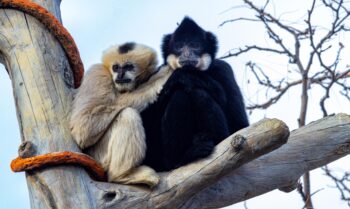September 28, 2021
Little Fish, Big Impact
How Denver Zoo is Helping the Effort to Reintroduce the Northern Redbelly Dace in Northern Colorado
They’re so small you’d never notice they were there, but with the help of the St. Vrain Valley School District Innovation Center, Denver Zoo, Colorado Parks and Wildlife, and Ocean First Institute and other local partners, the Northern redbelly dace is finally being reintroduced in Northern Colorado. More than a hundred people came to Pella Crossing in late August to celebrate the release, which was years in the making.
Saving the Northern Redbelly Dace
Northern Redbelly Dace (NRD) are a type of minnow that can be found in many areas of North America. In Colorado, there is only one remaining wild population, found south of Denver. There are several threats leading to the population decline of this fish; but the largest are predators that are non-native to CO, and human-involved habitat alteration. After the 2013 floods along the Front Range, many aquatic habitats were destroyed, and species like the NRD had no place to call home. As a result, Colorado Parks and Wildlife listed the NRD as a “Tier 1: Species of Greatest Conservation Need” in 2015.
With support from the Colorado Parks and Wildlife Native Aquatic Species Restoration Facility in Alamosa, students from the Innovation Center in Longmont began hatching and raising fish in their classroom. Not only did they need to successfully hatch the fish, but raise them to maturity, so they’d survive in their new habitat in Webster Pond. Pella Crossing is a popular fishing area in Longmont with many different ponds. After the floods, there was a significant amount of silt that had settled in Webster Pond. When Boulder Open Space and Colorado Parks and Wildlife looked at dredging Webster Pond, they decided to keep the pond shallow, to create a natural wetland habitat suitable for the Northern Redbelly Dace. To create an even better NRD habitat, local volunteers planted native vegetation, and a fishing ban for Webster Pond was passed. Once the habitat was suitable, Webster Pond was ready for fish!
Looking Ahead
These little fish will make a big splash in protecting many other species in the area. The goal is to establish a healthy, biodiverse environment. Data collected at Webster Pond will determine potential releases at other sites. To do that, we need to know that the fish are thriving in Webster Pond. To help monitor their progress, Denver Zoo educators James Garcia and Conor Kirby secured a conservation grant for robotics students at the Innovation Center. The funds secured from the Denver Zoo conservation department for the NRD project will be used for post-release monitoring of the species in Webster Pond, including artificial intelligence technology to identify the fish underwater using GoPro video cameras. Water quality testing will be ongoing to ensure that these little fish will thrive in their new wild habitat.
This isn’t the first time Denver Zoo has partnered with the Innovation Center students. In 2015 middle and high school students from the Innovation center built an underwater ROV to collect data for the Lake Titicaca Frog project in Peru. We’re proud to partner once again to support innovative technologies that will help save species right here in Colorado.
Subscribe
Be among the first to hear the latest animal updates, important stories and details about all the fun happening around Denver Zoo.
Tags
-
 April 15, 2024
April 15, 2024Good Luck, Chuck!
Good Luck, Chuck! Beloved Bachelor Relocating as Part of Asian Elephant Species Survival Plan In a heartfelt and collaborative…
-
 April 15, 2024
April 15, 2024African Impact
African Impact Two New African Field Conservation ProgramsAim to Protect Gorillas + Grey Crowned Cranes We're honored to provide…
-
 March 1, 2024
March 1, 2024Last Place(s) on Earth
Last Place(s) on Earth New Asian Field Conservation Programs Protect Asian Elephants, Sumatran Orangutans + more Indonesia's Leuser Ecosystem…

